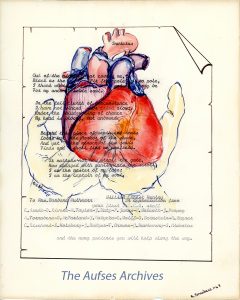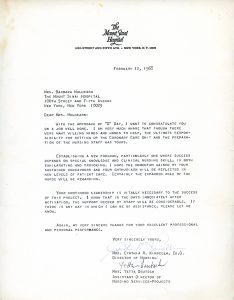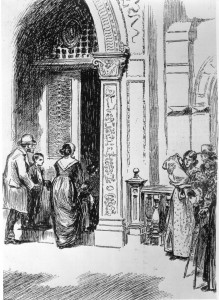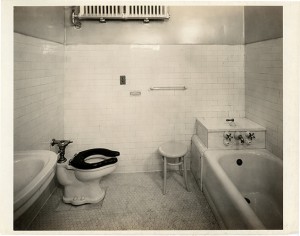Feb 21, 2018
Soon the Match will be upon the fourth year class and after months of deciding on a field, debating on various institutions, filling out paperwork and then smiling bravely through interviews, the new doctors will be on the resident staff of a hospital. This complex system of ‘matchmaking’ began in 1952 and replaced the practice of individuals applying to various residency programs, perhaps being measured against changeable and very subjective criteria.
In the early years of the 20th century, The Mount Sinai Hospital had in place a rigorous testing program to help winnow the number of applicants, leaving the ‘best and the brightest’ to face additional testing. Each year several hundred medical students would sit for the examinations that would lead to the selection of the twelve newest members of the house staff. The first day’s written examination was number coded, with the individuals’ names hidden so favoritism could not occur. The next day, the top scores were posted, and the 60 highest scorers would return for oral exams given by the medical staff. The questions were broad and usually designed to show a wide knowledge in the basic sciences and clinical medicine, as well as critical thinking skills. Questions on art or literature were not unknown, depending on the faculty member’s interests. The exam evolved over time to be more rigorous, and eventually recommendations from medical schools deans were also sought.
In 1930, these were some of the written questions the applicants were posed. How would you do?
1. In what stages of the following diseases would you terminate early pregnancy? a. Tuberculosis of the lungs b. Nephritisc. Diabetes d. Valvular heart disease
2. Under what conditions would you select for anesthesia? a. Chloroform b. Ether c. Nitrous oxide d. Spinal e. Local f. What special contra-indication for each?
3. In what illnesses may the joints be involved?
4. In what extra abdominal conditions may abdominal symptoms appear?
5. A patient has been operated upon for an acute gangrenous appendicitis with abscess. He had one chill prior to operation. Post-operative course is marked by fever of 102 to 104; high leucocytosis; polynucleosis. X-ray examination of the chest and right hypochondrium shows moderate elevation of right diaphragm. Discuss possible causes of the high temperature.
Dec 8, 2017
In October of this year, The Mount Sinai Hospital announced the opening of the new cardiac unit, the former Cardiac Care Unit (CCU), now located on KCC 6 in the Klingenstein Clinical Center. There are 20 beds, ten of which are the Cardiac Intensive Care Unit (CICU) and ten are step-down beds, the Cardiac Step Down Unit (CSDU). Unlike the other ICU units, the ten ICU beds are all private rooms. The entire unit is beautiful, with a receptionist desk as you get off the elevator.
It just so happens that last year, the Aufses Archives received a small set of papers from Barbara McPeek Mulhearn, RN, Class of 1962 of The Mount Sinai Hospital School of Nursing. Among those items was information about Mulhearn’s role in creating the first Cardiac Care ICU at the Hospital, which opened in 1968. Her title was Assistant Nursing Supervisor in charge of the Ames Coronary ICU, an eight bed unit on the 4th floor of KCC. The Unit opened February 19, 1968.
Shown below are two pieces from the collection: a drawing of a heart held in a person’s hands with the poem “Invictus” by William Ernest Henley typed over it. This was sent to Mulhearn from “her first I.C.C.U. staff,” in appreciation from them “and the many patients you will help along the way.” Also shown here is a letter from Dr. Cynthia Kinsella, the Director of Nursing at The Mount Sinai Hospital at the time, thanking Mulhearn for her efforts and encouraging her as they neared the Unit opening.
Fifty years on, the caring legacy continues.


Apr 15, 2016

Dr. S. S. Goldwater, Director of The Mount Sinai Hospital from 1903-1928
Every month is a celebration of something, and April is National Poetry Month. In keeping with the season, the Mount Sinai Archives would like to offer up a poem. This was written by S. S. Goldwater, MD (1873-1942). He served as the Director (COO) of The Mount Sinai Hospital from 1903-1928 and also served as the New York City Commissioner of Health and the Commissioner of Hospitals. He was known as one of the foremost consultants on hospital architecture in his era, and helped create the field of modern hospital administration. He loved to write poetry and often exchanged poems with his friends. He wrote the poem below for the celebration of The Mount Sinai Hospital’s 90th anniversary in 1942, just a few months before he died. It was reprinted in a memorial booklet after his death:
In closing, let me address these lines to your distinguished President, to your faithful and energetic Director, and to those members of the Board and Staff with whom it was my privilege to be associated for a time in the development of this great institution:
Full many a year has passed since you and I
Began to think in unison, and talk
Of what a hospital is and what it should be.
Well, thoughts like ours do not die a-borning
But, seized by eager wills, emerge as deeds,
By which new shapes are formed, reshaped again,
Until the world about us is part Nature’s,
Part our own.
Although we’ve not achieved
The perfect institution of our dreams—
Of love, and art, and science all compact—
Rejoice we may, for we have lived to see
The hospital we cherish yield to change
From small to great, from careless to exact,
From home of sorry pestilence to proud
And comely scene of perfect cleanliness
Equipped with all that science knows to aid
Physician, nurse, and sick, to whom in honor
We pledge again our faithful, firm support.
Mar 8, 2016

The entry to the Mount Sinai dispensary building where Dr. Welt served as chief of a pediatric clinic. This building on East 67th Street opened in 1890. In 1904 Dr. Welt moved with the clinic to the corner of Madison Avenue and 100th Street.
In honor of International Women’s Day, celebrated on March 8th, the Mount Sinai Archives wants to highlight a woman who is not remembered today, but who made a big impact on The Mount Sinai Hospital, Sara Welt Kakels, MD. Dr. Welt (1860-1943) was born in Czernowitz, Bukovina. She was one of four sisters, three of whom became physicians and the fourth a chemist. Sara Welt received her medical degree from the University of Zurich in 1885 and moved to New York City shortly thereafter to be with her sister, Dr. Rosa Welt Strauss, an ophthalmologist who also taught at The Mount Sinai Hospital School of Nursing.
In 1887, Dr. Welt was appointed to replace Mary Putnam Jacobi as one of the four heads of the Pediatrics clinics at the Hospital. She remained in charge of the clinic while she built a private practice in the community. In 1922 Sara Welt was the first woman to be appointed to the rank of Adjunct Pediatrician at Mount Sinai. She stepped down from active service in 1926 but remained closely affiliated with the Pediatrics Department until her death in 1943, at which time she bequeathed nearly $1,000,000 to Mount Sinai to establish the Sara Welt Memorial Fund, which established the Welt Fellowship program for young physicians who needed financial help, and also provided support of the Pediatric Clinic.
Dr. Welt married Moses S. Kakels, MD, a surgeon at the Mount Sinai clinics but primarily affiliated with Lebanon Hospital. Dr. Welt was very involved in teaching. She held appointments at the Women’s Medical College of the New York Infirmary, where she was an Instructor in the Practice of Medicine. She also lectured at The Mount Sinai Training School for Nurses on Anatomy and Physiology. She was an active member of The New York Academy of Medicine, as well as the New York Pathological Society. She had a pioneering interest in pediatric gynecology, and published over 20 articles on this and other topics.
When she died in 1943, the American Jewish Yearbook noted her final benevolence:
WELT-KAKELS, SARA (MRS. MOSES S. KAKELS), pediatrician Mt. Sinai Hosp., New York, N. Y., (d. Dec. 26, 1943), bequeathed to N. Y. Academy of Medicine $100,000 for aid of sick and needy physicians, $10,000 for lectureship by a pediatrician, and $20,000 for books and literature for library; $20,000 to Lebanon Hosp. for fellowship in surgery in honor of her husband; $10,000 to Hampton (Va.) Normal Agricultural Institute for establishment of four scholarships; and residuary estate, valued at $874,222, to Mt. Sinai Hosp., to set up “The Sara Welt Memorial Fund” ” and establish six traveling fellowships; reptd Feb. 6, 1946.
Sara Welt Fellows continued at The Mount Sinai Hospital for decades. Her support of these young doctors allowed her to touch the lives of thousands of patients.
Nov 19, 2015
November 18th is World Toilet Day, a phrase that seems strange – and funny! – to the ears. So, first some fun. Below are images of the fancy new bathroom, including a toilet, that Mount Sinai Hospital offered to the well-to-do paying patients in the new Private Pavilion that opened in 1921. It does not look like much today, but it had all the pieces and could be kept ‘sanitary,’ which was an important goal.
Which leads to the unfunny part about World Toilet Day. It exists for a reason. As the website for World Toilet Day notes: “Of the world’s seven billion people, 2.4 billion people do not have improved sanitation. 1 billion people still defecate in the open. Poor sanitation increases the risk of disease and malnutrition, especially for women and children.” (http://www.worldtoiletday.info/about)
Think about it, and go to the website to learn more.


For more on the Archives or the history of Mount Sinai, contact us at msarchives@mssm.edu






